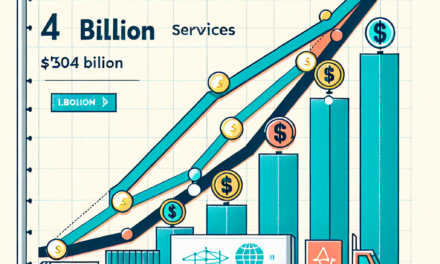“Euro Dips: Tariff Tensions Tug Currency to New Lows Against Dollar”
Introduction
In recent financial developments, the euro has experienced a significant decline, reaching its lowest level against the U.S. dollar since late June. This downturn is primarily attributed to escalating concerns over tariffs, which have heightened market uncertainty and impacted investor confidence. The currency’s depreciation reflects broader economic anxieties as trade tensions continue to influence global markets. As stakeholders assess the potential implications of these tariff disputes, the euro’s performance remains under close scrutiny, highlighting the intricate interplay between international trade policies and currency valuations.
Impact Of Tariff Concerns On Euro’s Decline Against The Dollar
The recent decline of the euro to its lowest level since late June against the dollar has sparked considerable attention in financial markets, with tariff concerns emerging as a significant factor influencing this downward trend. As global economic dynamics continue to evolve, the interplay between trade policies and currency valuations has become increasingly pronounced. The euro’s depreciation can be attributed to a confluence of factors, with tariff concerns playing a pivotal role in shaping investor sentiment and market behavior.
To begin with, the imposition of tariffs has historically been a tool used by governments to protect domestic industries from foreign competition. However, such measures often lead to retaliatory actions, creating a ripple effect that can disrupt international trade and economic stability. In the current scenario, the eurozone finds itself at the center of trade tensions, particularly with the United States. The prospect of increased tariffs on European goods has raised concerns about the potential impact on the eurozone’s export-driven economy. As a result, investors have become increasingly cautious, leading to a shift in capital flows towards the perceived safety of the U.S. dollar.
Moreover, the euro’s decline is further exacerbated by the broader economic uncertainties that accompany tariff disputes. The eurozone, already grappling with sluggish growth and inflationary pressures, faces additional challenges as trade tensions threaten to undermine its economic recovery. The European Central Bank (ECB) has been closely monitoring these developments, as any prolonged weakness in the euro could complicate its monetary policy objectives. A weaker euro, while potentially boosting exports by making them cheaper on the global market, also raises the cost of imports, thereby contributing to inflationary pressures.
In addition to these economic considerations, the psychological impact of tariff concerns cannot be underestimated. Financial markets are highly sensitive to geopolitical developments, and the mere anticipation of trade disruptions can trigger significant volatility. Investors, seeking to mitigate risk, often flock to safe-haven assets such as the U.S. dollar, which is perceived as more stable in times of uncertainty. This flight to safety further amplifies the downward pressure on the euro, as demand for the dollar increases.
Furthermore, the euro’s decline against the dollar is not occurring in isolation. It is part of a broader trend of currency fluctuations driven by global trade dynamics. Other currencies, particularly those of emerging markets, have also experienced volatility as investors reassess their risk exposure in light of escalating trade tensions. This interconnectedness underscores the complexity of the current economic landscape, where decisions made in one part of the world can have far-reaching implications for currency markets globally.
In conclusion, the euro’s fall to its lowest level since late June against the dollar is a multifaceted issue, deeply intertwined with tariff concerns and broader economic uncertainties. As trade tensions continue to evolve, the eurozone must navigate these challenges carefully to safeguard its economic stability. Policymakers and investors alike will need to remain vigilant, as the interplay between trade policies and currency valuations will likely continue to shape the financial landscape in the months ahead. The situation serves as a reminder of the intricate connections between global trade, economic policy, and currency markets, highlighting the need for coordinated efforts to address the underlying issues driving these developments.
Historical Analysis: Euro’s Lowest Levels Since Late June
The euro has recently experienced a significant decline, reaching its lowest level against the dollar since late June. This development has sparked considerable interest and concern among economists and investors alike, as it reflects broader economic dynamics and geopolitical tensions. To understand the implications of this decline, it is essential to examine the historical context and the factors contributing to the euro’s current position.
Historically, the euro has faced numerous challenges that have influenced its value against the dollar. Since its inception in 1999, the euro has been subject to fluctuations driven by economic policies, political events, and market sentiment. The recent drop to its lowest level since late June can be attributed to a confluence of factors, with tariff concerns playing a pivotal role. The imposition of tariffs has long been a contentious issue, affecting international trade and economic stability. In recent months, escalating trade tensions between major economies have heightened uncertainty, leading to shifts in currency valuations.
The euro’s decline can be partly attributed to the ongoing trade disputes between the European Union and other global powers, particularly the United States. As tariffs are imposed and retaliatory measures are considered, the economic outlook becomes increasingly uncertain. This uncertainty tends to drive investors towards safer assets, such as the U.S. dollar, which is often perceived as a stable haven during turbulent times. Consequently, the demand for the euro diminishes, exerting downward pressure on its value.
Moreover, the eurozone’s economic performance has been a contributing factor to the currency’s depreciation. Recent economic indicators have painted a mixed picture, with some member states experiencing sluggish growth and others grappling with structural challenges. This uneven economic landscape has raised concerns about the eurozone’s overall resilience, further influencing investor sentiment. As a result, the euro has struggled to maintain its strength against the dollar, which has been buoyed by relatively robust economic data from the United States.
In addition to these economic factors, monetary policy decisions have also played a crucial role in shaping the euro’s trajectory. The European Central Bank (ECB) has maintained a cautious approach, balancing the need to support economic growth with the imperative to manage inflation. However, the divergence in monetary policy between the ECB and the U.S. Federal Reserve has contributed to the euro’s decline. While the Federal Reserve has signaled a more aggressive stance in addressing inflationary pressures, the ECB has remained more measured, leading to a widening interest rate differential that favors the dollar.
Looking ahead, the euro’s future trajectory will likely depend on a range of factors, including the resolution of trade disputes, economic performance within the eurozone, and the direction of monetary policy. While the current situation presents challenges, it also offers opportunities for policymakers to address underlying issues and strengthen the eurozone’s economic foundations. By fostering greater economic integration and implementing structural reforms, the eurozone can enhance its resilience and potentially reverse the currency’s downward trend.
In conclusion, the euro’s fall to its lowest level since late June against the dollar underscores the complex interplay of economic and geopolitical factors influencing currency markets. As tariff concerns and economic uncertainties persist, the euro faces significant headwinds. However, by addressing these challenges and pursuing strategic reforms, the eurozone can work towards stabilizing its currency and ensuring long-term economic stability.
Economic Implications Of A Weakening Euro
The recent decline of the euro to its lowest level since late June against the dollar has sparked considerable discussion among economists and policymakers about the broader economic implications. This depreciation is largely attributed to escalating concerns over tariffs, which have introduced a layer of uncertainty in the global economic landscape. As the euro weakens, several interconnected economic consequences emerge, affecting both the Eurozone and its trading partners.
To begin with, a weaker euro can have a mixed impact on the Eurozone’s export-driven economies. On one hand, it can make European goods and services more competitively priced in international markets, potentially boosting exports. This could be particularly beneficial for countries like Germany, which rely heavily on exports to sustain economic growth. However, the benefits of increased export competitiveness may be offset by the rising costs of imports. As the euro loses value against the dollar, the cost of importing goods priced in dollars, such as oil and other commodities, increases. This can lead to higher production costs for European businesses, which may eventually be passed on to consumers in the form of higher prices.
Moreover, the depreciation of the euro can have significant implications for inflation within the Eurozone. A weaker currency can contribute to imported inflation, as the cost of foreign goods and services rises. This scenario poses a challenge for the European Central Bank (ECB), which has been striving to maintain price stability while supporting economic growth. If inflationary pressures mount, the ECB may face the difficult decision of whether to adjust its monetary policy stance, potentially tightening it to curb inflation, which could, in turn, dampen economic growth.
In addition to these domestic considerations, the weakening euro also has ramifications for international financial markets. Investors often view currency fluctuations as indicators of broader economic health and stability. A declining euro may lead to shifts in investment flows, as investors seek to capitalize on currency movements or hedge against potential risks. This can result in increased volatility in financial markets, affecting everything from stock prices to bond yields.
Furthermore, the euro’s depreciation against the dollar can influence the balance of trade between the Eurozone and the United States. As European goods become cheaper for American consumers, the U.S. trade deficit with the Eurozone could widen. This dynamic may exacerbate existing trade tensions, particularly if it is perceived as giving European exporters an unfair advantage. In such a scenario, the risk of retaliatory trade measures, including tariffs, could increase, further complicating the global trade environment.
In conclusion, the euro’s fall to its lowest level since late June against the dollar is a development with far-reaching economic implications. While it may offer some short-term benefits to Eurozone exporters, the potential for increased import costs, inflationary pressures, and financial market volatility cannot be overlooked. Policymakers and businesses alike must navigate these challenges carefully, balancing the need for economic growth with the imperative of maintaining stability. As the situation evolves, close attention to currency movements and their underlying causes will be essential in formulating effective economic strategies.
Currency Market Reactions To Euro’s Fall
The recent decline of the euro to its lowest level since late June against the dollar has sparked significant reactions in the currency markets, with various factors contributing to this downward trend. The euro’s depreciation can be primarily attributed to escalating concerns over potential tariffs, which have created an atmosphere of uncertainty and apprehension among investors. As these concerns intensify, market participants are increasingly seeking refuge in the relative safety of the U.S. dollar, thereby exerting additional downward pressure on the euro.
In recent weeks, the specter of tariffs has loomed large over the European economy, with potential implications for trade relations and economic growth. The possibility of new tariffs being imposed has raised fears of a trade war, which could have far-reaching consequences for the eurozone’s economic stability. This uncertainty has led investors to reassess their positions, prompting a shift away from the euro in favor of more stable currencies. Consequently, the euro has experienced a marked decline, reflecting the market’s apprehension about the future trajectory of the European economy.
Moreover, the euro’s fall is not occurring in isolation but is part of a broader trend of currency fluctuations driven by geopolitical tensions and economic policy decisions. The interplay between these factors has created a complex environment in which currency values are subject to rapid changes. In this context, the euro’s decline can be seen as a response to both external pressures and internal economic challenges facing the eurozone. As investors navigate this intricate landscape, their decisions are influenced by a myriad of factors, including interest rate differentials, economic data releases, and geopolitical developments.
In addition to tariff concerns, the euro’s depreciation is also linked to the relative strength of the U.S. dollar, which has been bolstered by robust economic data and expectations of further interest rate hikes by the Federal Reserve. The divergence in monetary policy between the European Central Bank and the Federal Reserve has contributed to the widening interest rate differential, making the dollar more attractive to investors seeking higher returns. This dynamic has further exacerbated the euro’s decline, as capital flows increasingly favor the dollar over the euro.
Furthermore, the euro’s weakness has implications for the broader global economy, as currency fluctuations can impact trade balances, inflation rates, and economic growth. A weaker euro may provide a temporary boost to European exports by making them more competitive on the global market. However, it also poses challenges, particularly in terms of import costs and inflationary pressures. As the eurozone grapples with these complexities, policymakers must carefully consider their responses to ensure economic stability and growth.
In conclusion, the euro’s fall to its lowest level since late June against the dollar is a reflection of the multifaceted challenges facing the currency markets. Tariff concerns, coupled with the relative strength of the U.S. dollar and broader geopolitical tensions, have created an environment of uncertainty that has prompted investors to reevaluate their positions. As the situation continues to evolve, market participants will closely monitor developments and adjust their strategies accordingly. The euro’s trajectory will depend on a range of factors, including economic data, policy decisions, and geopolitical events, all of which will shape the future of the currency markets.
Eurozone’s Economic Strategies Amid Currency Fluctuations
The recent decline of the euro to its lowest level since late June against the dollar has sparked renewed discussions about the Eurozone’s economic strategies amid currency fluctuations. This depreciation is largely attributed to growing concerns over potential tariffs, which have cast a shadow over the region’s economic outlook. As the euro weakens, it becomes imperative to examine the underlying factors contributing to this trend and the strategies that the Eurozone might employ to navigate these turbulent waters.
To begin with, the euro’s decline can be linked to a combination of external and internal pressures. Externally, the specter of tariffs, particularly those that might be imposed by the United States, has created an atmosphere of uncertainty. These tariffs could potentially disrupt trade flows, affecting key European industries and, consequently, the overall economic stability of the region. Internally, the Eurozone is grappling with its own set of challenges, including sluggish economic growth and varying fiscal policies among member states. These factors collectively contribute to a lack of investor confidence, which in turn exerts downward pressure on the euro.
In response to these challenges, the European Central Bank (ECB) plays a crucial role in stabilizing the currency and fostering economic growth. The ECB’s monetary policy decisions, such as interest rate adjustments and quantitative easing measures, are pivotal in influencing the euro’s value. By maintaining a careful balance between stimulating growth and controlling inflation, the ECB aims to create a conducive environment for economic recovery. However, the effectiveness of these measures is often contingent upon the broader geopolitical landscape, which can either amplify or mitigate their impact.
Moreover, the Eurozone’s economic strategies must also consider the diverse economic conditions of its member states. The heterogeneity within the region means that a one-size-fits-all approach may not be feasible. Instead, tailored strategies that address the specific needs and challenges of individual countries are essential. For instance, countries with higher debt levels may require different fiscal policies compared to those with more robust economies. This necessitates a coordinated effort among member states to ensure that economic policies are harmonized and mutually beneficial.
In addition to monetary and fiscal policies, structural reforms are vital for enhancing the Eurozone’s resilience to currency fluctuations. These reforms could include measures to improve labor market flexibility, boost productivity, and foster innovation. By strengthening the underlying economic framework, the Eurozone can better withstand external shocks and maintain a stable currency.
Furthermore, the role of international cooperation cannot be overlooked. Engaging in dialogue with major trading partners and participating in multilateral forums can help mitigate the impact of potential tariffs and promote a more stable global economic environment. By advocating for open and fair trade practices, the Eurozone can work towards reducing the uncertainties that currently weigh on the euro.
In conclusion, the euro’s recent decline against the dollar underscores the need for comprehensive economic strategies within the Eurozone. By addressing both internal and external challenges through a combination of monetary policy, fiscal coordination, structural reforms, and international cooperation, the region can enhance its economic resilience. As the Eurozone navigates these complex dynamics, the focus must remain on fostering sustainable growth and ensuring long-term stability for its currency and economy.
Comparing Euro And Dollar: A 2023 Perspective
In 2023, the global financial landscape has been marked by significant fluctuations in currency values, with the euro experiencing notable depreciation against the dollar. Recently, the euro fell to its lowest level since late June, a development that has captured the attention of economists and investors alike. This decline can be attributed to a confluence of factors, with tariff concerns playing a pivotal role in shaping market dynamics. As we delve into the intricacies of this currency comparison, it is essential to understand the broader economic context and the implications of these shifts.
The euro’s recent decline against the dollar is not an isolated incident but rather a reflection of underlying economic tensions. One of the primary drivers of this trend is the growing apprehension surrounding tariffs and trade policies. In recent months, discussions about potential tariffs have intensified, particularly between major economic blocs. These discussions have created an atmosphere of uncertainty, prompting investors to seek safer assets, such as the U.S. dollar, which is traditionally viewed as a haven during times of economic instability.
Moreover, the economic performance of the Eurozone has been relatively sluggish compared to that of the United States. While the U.S. economy has shown resilience, with robust job growth and consumer spending, the Eurozone has faced challenges such as lower growth rates and inflationary pressures. These disparities in economic performance have further contributed to the euro’s depreciation, as investors are more inclined to invest in economies with stronger growth prospects.
In addition to economic performance, monetary policy decisions have also played a crucial role in influencing currency values. The European Central Bank (ECB) has maintained a more accommodative stance, keeping interest rates low to stimulate growth. In contrast, the Federal Reserve has adopted a more hawkish approach, gradually raising interest rates to combat inflation. This divergence in monetary policy has made the dollar more attractive to investors seeking higher returns, thereby exerting downward pressure on the euro.
Furthermore, geopolitical factors have added another layer of complexity to the euro-dollar dynamic. Political uncertainties, such as elections and policy shifts within the Eurozone, have contributed to market volatility. These uncertainties can lead to fluctuations in investor confidence, impacting currency values. In contrast, the relative political stability in the United States has bolstered the dollar’s appeal.
As we consider the implications of the euro’s decline, it is important to recognize the potential consequences for both the Eurozone and the global economy. A weaker euro can have mixed effects; on one hand, it can boost exports by making Eurozone goods more competitive in international markets. On the other hand, it can increase the cost of imports, contributing to inflationary pressures within the region.
In conclusion, the recent fall of the euro to its lowest level since late June against the dollar underscores the complex interplay of economic, monetary, and geopolitical factors. As tariff concerns continue to loom large, the currency markets are likely to remain volatile. For policymakers and investors, understanding these dynamics is crucial in navigating the challenges and opportunities that lie ahead. As we move forward, the evolving relationship between the euro and the dollar will undoubtedly remain a focal point in the broader discourse on global economic stability.
Future Projections For The Euro In Light Of Tariff Issues
The euro has recently experienced a significant decline, reaching its lowest level against the dollar since late June. This depreciation is largely attributed to escalating concerns over tariffs, which have introduced a new layer of uncertainty into the global economic landscape. As market participants grapple with the implications of these trade tensions, the future trajectory of the euro remains a topic of considerable debate and analysis.
To understand the potential future movements of the euro, it is essential to consider the broader context of international trade relations. The imposition of tariffs often leads to retaliatory measures, creating a cycle of economic friction that can disrupt trade flows and impact currency valuations. In this scenario, the eurozone, with its export-driven economy, is particularly vulnerable. The imposition of tariffs on European goods by major trading partners could lead to a decrease in demand for these products, thereby exerting downward pressure on the euro.
Moreover, the uncertainty surrounding tariffs can also affect investor sentiment, which plays a crucial role in currency markets. Investors tend to seek safe-haven assets during times of economic uncertainty, and the U.S. dollar often benefits from this flight to safety. Consequently, as concerns over tariffs persist, the euro may continue to face headwinds against the dollar. This dynamic underscores the importance of monitoring geopolitical developments and trade negotiations, as any resolution or escalation could significantly influence currency movements.
In addition to trade-related factors, the euro’s future performance will also be shaped by economic indicators and monetary policy decisions within the eurozone. The European Central Bank (ECB) plays a pivotal role in this regard, as its policy stance can either bolster or weaken the euro. Should the ECB decide to implement further monetary easing measures in response to sluggish economic growth or inflationary pressures, the euro could experience additional depreciation. Conversely, a more hawkish approach, signaling confidence in the eurozone’s economic recovery, might provide some support to the currency.
Furthermore, it is important to consider the potential impact of external economic conditions on the euro. The global economic environment is interconnected, and developments in other major economies, such as the United States and China, can have ripple effects on the eurozone. For instance, a slowdown in the Chinese economy could reduce demand for European exports, while robust economic growth in the United States might lead to a stronger dollar, both of which could negatively affect the euro.
Looking ahead, the euro’s future will likely be influenced by a combination of these factors, making it challenging to predict with certainty. However, by closely monitoring trade negotiations, economic indicators, and central bank policies, market participants can gain valuable insights into potential currency movements. It is also crucial for policymakers to address the underlying issues contributing to trade tensions, as a resolution could alleviate some of the downward pressure on the euro.
In conclusion, the euro’s recent decline against the dollar amid tariff concerns highlights the complex interplay of factors that influence currency markets. While the future trajectory of the euro remains uncertain, understanding the various elements at play can provide a clearer picture of potential outcomes. As the global economic landscape continues to evolve, staying informed and adaptable will be key for those navigating the challenges and opportunities presented by currency fluctuations.
Q&A
1. **What caused the Euro to fall to its lowest level since late June against the Dollar?**
Concerns over tariffs and trade tensions between the European Union and the United States.
2. **When did the Euro reach this low level against the Dollar?**
The Euro fell to this level in early October 2019.
3. **What specific economic concerns are affecting the Euro?**
Potential tariffs on European goods by the United States and overall trade uncertainty.
4. **How do tariffs impact currency values?**
Tariffs can lead to economic uncertainty, affecting trade balances and investor confidence, which can weaken a currency.
5. **What other factors might be contributing to the Euro’s decline?**
Sluggish economic growth in the Eurozone and monetary policy decisions by the European Central Bank.
6. **How does the Dollar’s strength relate to the Euro’s weakness?**
The Dollar often strengthens as a safe-haven currency during times of global economic uncertainty, contributing to the Euro’s relative weakness.
7. **What are the potential implications of a weaker Euro for the Eurozone economy?**
A weaker Euro can make Eurozone exports more competitive but may also increase the cost of imports, potentially leading to inflationary pressures.
Conclusion
The euro’s decline to its lowest level since late June against the dollar can be attributed to escalating concerns over tariffs, which have heightened market uncertainty and affected investor confidence. The imposition or threat of tariffs can disrupt trade flows, impact economic growth, and lead to currency volatility. As investors seek safer assets, the dollar often benefits, leading to a depreciation of the euro. This situation underscores the sensitivity of currency markets to geopolitical and economic developments, highlighting the need for careful monitoring of trade policies and their potential implications on global financial stability.





